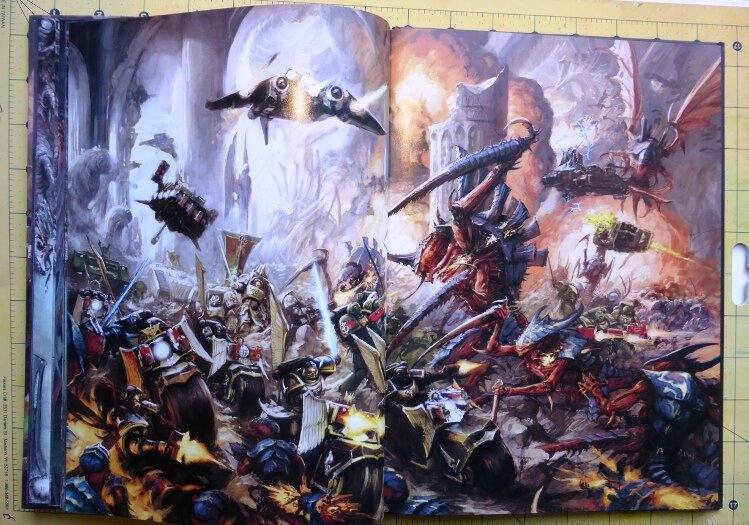
Today’s the day. The new Tyranid codex is officially released and in stores along with the new Tyranid miniatures. The first Warhammer 40K codex of 2014. The first Warhammer 40K codex officially written by the “Games Workshop Design Team”, rather than a specific lead-author.
Moreover, this seems to be a codex that is getting a very bad reception in many forums and blogs, which may or may not be warranted (I cannot tell you at this point, to be honest).
Either way, I spend a nice morning with the book and a cup of coffee. A few thoughts on the (physcial) Tyranid codex.
#1 – The Tyranid Codex in my Hands
For a start, the Tyranid codex looks like all 6th Edition codexes for Warhammer 40K so far. It’s back down to 105 pages, just like the Eldar or Chaos Daemon codexes, for example. Not the thicker version we got for Space Marines.
Using the Eldar codex as a comparison (the most recent codex with the same page-count), the Tyranid codex actually packs a bit more fluff. Some 26 or so pages of background, plus a few gorgeous double-page (see above) and single-page spreads. The description of the army and units doesn’t start until page 38. In comparison, the Eldar codex only had about 16 pages of background, and fewer art-pieces early on, starting the army-discussion itself at page 25.

Background (and art) seems to be at slight premium in the new Tyranid codex. I believe they gave themselves the extra space by occasionally squeezing several units on a single page, instead of using a full-page for every choice in the army list.
Biovores and the new Exocrine are grouped under “Artillery Organisms”, for example, while Pyrovores and the new Haruspex share the “Feeder Organisms”-page.
Overall, I think it’s a good change, though I haven’t read the entire background section yet (though what I read isn’t bad).
#2 – New Tyranid Units

Speaking of the Haruspex, there are of course all the new entries for the new miniatures. As noted above, the rules seem to be getting a lot of hate on the interwebs so far (even compared to “normal” Games Workshop releases). That hate may or may not be justified.
As a “Tyranid-neophyte”, I found them to be fun to read. The new Haruspex for example regenerates wounds for gobbling up enemy units (Nom-Nom!) and comes with a biomorph rule that’s literally called “Gulp!“. I love it. To me, the new Tyranid codex was more fun read than the slightly dry Space Marines codex (though the author might be the same…?).
The Haruspex miniature also gave me déjà-vues of the Vortex Beast from Fantasy. The latter, in my opinion, is the slightly more Cthulhu cooler miniature. Would be fun to see Vortex Beast as proxy for a Haruspex in a 40K Chaos Army (“Gulp!“).
#3 – Miniature Showcase

Right before the army list itself, you’ll find the display section of the miniatures.
The miniatures-show-case-section in the Tyranid codex (22 pages) is likewise slightly larger than the one in the Eldar codex (18 page).
There also seem to be more double-page spreads like the one above that show the new miniatures in a “fight-scene”, with terrain, opponents, etc.., rather than the single miniatures before a white background (which are still there, of course).
#4 – The Lost Nids
Another hot topic, of course, is that a few old Tyranid units have gone the way of the Squats.
The Mycetic Spore is gone, not just from the rules, but (on a casual first read) from the background entirely. Likewise the Doom of Malan’tai, the Parasite of Mortrex and Ymgarl Genestealers. The latter, at least, can be build with a “Bio-Artefact” named “Ymgarl Factor”.
#5 – Thoughts
For better or worse, the new Tyranid codex seems to be a codex that people love to hate, and possibly the rules do have issues. Usually, it takes me a few weeks to truly get to grip with things in the game itself.
Furthermore, a few old units have been cut, which is going to annoy people with a collection that includes models for these units. It certainly isn’t helping the codex at the moment.
However, as a physical product, I enjoy the book. The visuals are top notch, as we’ve come to expect from Warhammer 40K 6th Edition codexes over the past year-and-a-bit. More room was given to background and miniature-showcases, while the unit descriptions were handled more economically, which is a change I like.
The writing itself feels slightly more fun than, say, the Space Marines or Dark Angels codex, nor did I immediately find quite as many spelling mistakes as I did with the former.
Thus my verdict (as a person without a Tyranid army): an enjoyable book that I look forward to reading more in-depth in the coming months!
Z.








